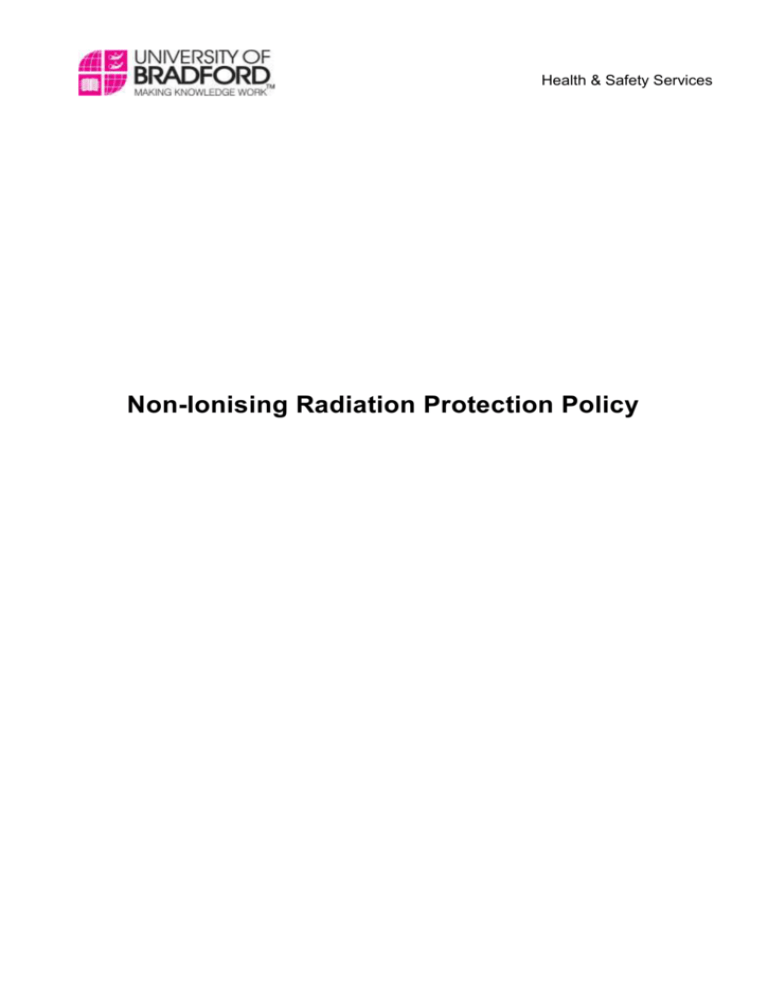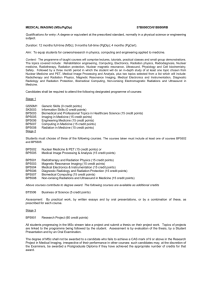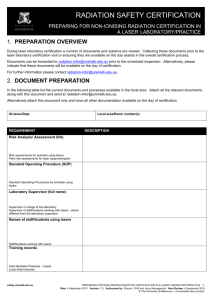Non-Ionising Radiation Protection Policy
advertisement

Health & Safety Services Non-Ionising Radiation Protection Policy Table of Contents 1. Purpose ................................................................................................................................. 2 2. Scope and Objectives............................................................................................................ 2 3. Definitions.............................................................................................................................. 2 4. Principles ............................................................................................................................... 2 4.1 Basic Safety Principles ................................................................................................... 2 4.2 Performance Standards and Auditing ............................................................................. 3 5. Responsibilities ..................................................................................................................... 3 5.1 Vice Chancellor ............................................................................................................... 3 5.2 Laser Protection Adviser (LPA) ....................................................................................... 3 5.3 Dean of School ............................................................................................................... 3 5.4 Head of Department........................................................................................................ 4 5.5 Protection Supervisors (Laser, Artificial Optical Radiation or other Non-Ionising Radiation) ................................................................................................................................. 4 5.6 Responsibilities of All Staff & Students ........................................................................... 4 6. References ............................................................................................................................ 5 7. Policy Review ........................................................................................................................ 5 8. Ratification............................................................................................................................. 5 Appendix A................................................................................................................................... 6 Basic Safety Principles ............................................................................................................. 6 Appendix B................................................................................................................................... 7 Duties of a Protection Supervisor ............................................................................................. 7 1 1. Purpose This Policy is intended to confirm those management arrangements that have been made for the identification, assessment and subsequent removal or reduction of risks to staff, students and visitors arising from the use of potentially hazardous sources of non-ionising radiation on behalf of the University. 2. Scope and Objectives The Policy outlines and describes the University's uses of potentially hazardous sources of nonionising radiations and the legislation which pertains to those uses. The various organisational arrangements necessary to implement and ensure compliance with the legislation are also described, including the major aspects of documentation and necessary record keeping. The Policy describes the main basic safety principles that must be followed when potentially hazardous sources of non-ionising radiations are used. The Policy accepts that advice and accepted standards in practice and non-ionising radiation protection from various professional bodies are under constant review and development. Therefore, the Policy formalises the management of this advice and adopted standards rather than defining in detail the standards themselves. The Policy contains a number of appendices, outlining the current staff with specific responsibilities in respect of the Policy and outlines those sections of particular relevance to the key personnel and other staff groups. The University recognises that safe systems of work are dependent on the users of non-ionising radiations and the facilities, equipment, training and competence of these staff, as well as the procedures developed to minimise the risk of harm due to improper use of non-ionising radiations. 3. Definitions Controlled Area is an area used for work with non- ionising radiation where significant nonionising radiation doses are possible and where special controls and working practices are required. Local Rules are a basic safety system and systems of work drawn up by the local Laser Protection Supervisor for use in Laser and Non-Ionising Radiation Controlled Areas. 4. Principles 4.1 Basic Safety Principles Staff and students working with potentially hazardous sources of non-ionising radiation will follow the basic safety principles laid out in Appendix A of this Policy. 2 4.2 Performance Standards and Auditing Compliance with the legislation is monitored by: Regular inspection and internal audit by Managers under the auspices of the Laser Protection Adviser; and External audit by the appropriate administrative bodies such as the Health & Safety Executive. Key audit items will include checking compliance with: The University’s written procedures made under Management of Health & Safety at Work Regulations 1999 (as amended 2008) & Artificial Optical Radiations at Work Regulations 2010; and The keeping of written records, including risk assessment, as required by those Regulations. Compliance will be co-ordinated by the Laser Protection Adviser for those issues pertaining to the uses of non-ionising radiation by the University. An annual report will be made by the Laser Protection Adviser to the University based on information received, highlighting all the above key indicators. 5. Responsibilities 5.1 Vice Chancellor The Vice Chancellor has overall statutory and operational responsibility for managing issues arising from the uses of non-ionising radiation in the University. 5.2 Laser Protection Adviser (LPA) The Laser Protection Adviser is appointed to advise the University on all matters pertaining to the uses of non-ionising radiation. Duties include monitoring the use of non-ionising radiation within the University, and advising the University on all matters of safety regarding the use of non-ionising radiation. The LPA will report any breaches of the appropriate legislation through Health & Safety Services to the most senior responsible University manager available, so that management is briefed, in particular prior to reporting any non-compliance(s) with the appropriate enforcing authority if required under legislation. Advice on non-ionising radiation protection issues is available to all staff on request, although risk assessments, reports and formal contact are usually arranged through Health & Safety Services. 5.3 Dean of School The School must integrate the management of work with non-ionising radiation into its operational and business processes. The Dean bears overall responsibility for the implementation and monitoring of the principles established by this Policy. This is achieved by 3 the enforcement of appropriate management practices and procedures, and the provision of adequate resource. The Head of Health and Safety Services and Laser Protection Adviser will advise the School on its role. The School will ensure that joint ventures maintain an adequate level of safety management as defined in this Policy. 5.4 Head of Department The Head of Department is responsible for the implementation of this policy within designated laboratories or other areas following consultation with the School management. The Head of Department has an overall responsibility for the establishment of an appropriate, effective and efficient management system. This includes, but is not limited to the following aspects: Ensure that Health & Safety Services are informed of any purchases or acquisition of equipment that produces potentially hazardous levels of non-ionising radiation; Appropriate risk assessments are made, training is given and relevant safety information made available to individuals working with potentially hazardous sources of non-ionising radiation. Records of this assessment, training and information are made available to the employee and the Laser Protection Adviser; They appoint sufficient numbers of suitably-qualified and trained personnel to act as Laser Protection Supervisors (for lasers) and personnel with specific safety responsibilities in all work areas designated for use with other non-ionising radiation; They draw up and maintain written safety procedures as required under Managing Health & Safety at Work Regulations 1999(as amended 2008) and Artificial Optical Radiations at Work Regulations 2010; Contingency plans exist so that any failure of systems and/or equipment resulting in an incident involving non-ionising radiation is adequately dealt with in a timely manner and that the Laser Protection Adviser is notified as soon as practicable; They maintain a programme of internal audit of compliance with Local Rules and procedures. 5.5 Protection Supervisors (Laser, Artificial Optical Radiation or other Non-Ionising Radiation) Perform the duties outlined in Appendix B of this Policy. 5.6 Responsibilities of All Staff & Students All members of staff & students have a duty to protect themselves, their colleagues and others from all hazards arising from their work. For this reason, those working with potentially hazardous sources of non-ionising radiation must become familiar with and observe the Local Rules for that area. 4 Anyone unfamiliar with work using potentially hazardous sources of non-ionising radiation must follow the direction of persons responsible for that area or task and comply with their direction under the systems of work laid out in the Local Rules for that area. Reporting of any incidents or non-compliance with Local Rules must be made in accordance with those Local Rules and through the University’s Incident Reporting Procedure. 6. References Management of Health & Safety at Work Regulations 1999 as amended 1999 [MHSWR]; Control of Artificial Optical Radiations at Work Regulations 2010 [AOR]; AURPO Guidance on the Safe Use of Lasers in Education and Research, AURPO Guidance Note No.7, 2012 edition 7. Policy Review This policy will be reviewed every two years. 8. Ratification This policy was developed by Health and Safety Services and Your RPA and approved by the Health and Safety Committee on 28 January 2013. 5 Appendix A Basic Safety Principles A1 Staff or students working with non-ionising radiations must ensure that all necessary steps are taken to minimise, so far as is reasonably practicable, exposure of staff, students and members of the public to hazardous levels of non-ionising radiations used within the University. A2 All equipment that delivers or controls the production of non-ionising radiations within the University must be constructed, installed and maintained such that it minimises the risk of hazardous exposure, consistent with its uses. The installation process must include a critical examination of the equipment, a regular maintenance programme and tests of performance and safety at regular intervals (Quality Assurance) with written records of the results kept for audit and review. A3 All staff and students must undergo sufficient instruction and training prior to work with potentially hazardous sources of non-ionising radiations such that they are able to perform their duties safely with respect to themselves, other staff, students and members of the public. This is based on attendance at the University’s Laser or other non-ionising radiation safety training courses or some other course recognised by the University to demonstrate that training has taken place to an appropriate level for the task to be undertaken safely. A4 Staff or students wishing to use potentially hazardous sources of non-ionising radiations must complete the appropriate University Registration Form and have the work cleared by Health & Safety Services prior to starting work with radiation. A5 Any suspected unintentional exposure of staff, students or visitors of the public to hazardous levels of non-ionising radiations must be reported to the appropriate LPS or safety supervisor at the earliest possible opportunity, who will conduct an investigation taking advice from the LPA where necessary. The results of that investigation must be reported through the University Incident Reporting Procedure. Enforcing authorities such as the HSE will be notified in accordance with statutory obligations. A9 Any breaches of this Policy or Local Rules will be investigated by the Laser Protection Supervisor and Health & Safety Services, who will liaise with the Laser Protection Adviser as appropriate. Action may be taken as a result of that investigation to suspend the work with potentially hazardous sources of non-ionising radiation and to recommend appropriate disciplinary action. 6 Appendix B Duties of a Protection Supervisor (Laser Protection Supervisor; or any other Non-Ionising Radiation Protection Supervisor) The following duties apply in respect of all uses of lasers in the University. The Laser Protection Supervisor/Non-Ionising Radiation Protection Supervisor shall; 1. Ensure compliance with Health & Safety at Work Act 1974, Management of Health & Safety at Work Regulations 1999 (as amended 2008) and Artificial Optical Radiations at Work Regulations 2010 as appropriate; 2. Ensure appropriate risk assessments are carried out to identify the particular hazards with the use of the equipment, taking advice from the Laser Protection Adviser or others as appropriate; 3. In consultation with the Laser Protection Adviser, draw up Local Rules for use in each work area with potentially hazardous sources of non-ionising radiation, describing the arrangements in the University for meeting the requirements of the regulations and maintaining safe systems of work. 4. Copies of Local Rules must be displayed in each non-ionising radiation work area, and central copies held by the Laser Protection Supervisor/Non-Ionising Radiation Protection Supervisor and Health & Safety Services. All Local Rules should be reviewed by the Laser Protection Supervisor/Non-Ionising Radiation Protection Supervisor in the light of any major changes to working practices within the area, or at least every two years whichever is the sooner. 5. Ensure all staff, students and visitors are adequately instructed about non-ionising radiation hazards and precautions they need to observe (particularly the appropriate use of safety equipment). 6. Arrange that each member of staff or student working in Laser Controlled Areas or other areas with potentially hazardous levels of non-ionising radiations is familiar with the Local Rules and signs a statement that he or she has read them and agrees to act in accordance with them; 7. Report immediately to the Head of Department on unsatisfactory conditions of nonionising radiation safety and to propose measures to remedy them and to confirm that agreed remedies have been effected; 8. Ensure that Health & Safety Services are consulted when it is proposed to alter the operating conditions of installations whether by new or modified buildings or equipment, or by change of procedures or workload; 9. Report directly to Health & Safety Services when necessary in the interest of safety; 7 10. Ensure that potentially hazardous exposures of staff or patients as defined in Local Rules are reported to the University via the University’s Incident Reporting Systems; 11. Arrange that checks on the maintenance of equipment safety features are completed, as specified in Local Rules; 12. Arrange that personal protective equipment is examined as specified in Local Rules and that any deficiencies are reported; 13. Receive appropriate training and attend updates regarding their statutory duties when acting as Laser Protection Supervisor/Non-Ionising Radiation Protection Supervisor as and when deemed appropriate by their Manager and Health & Safety Services. 8






